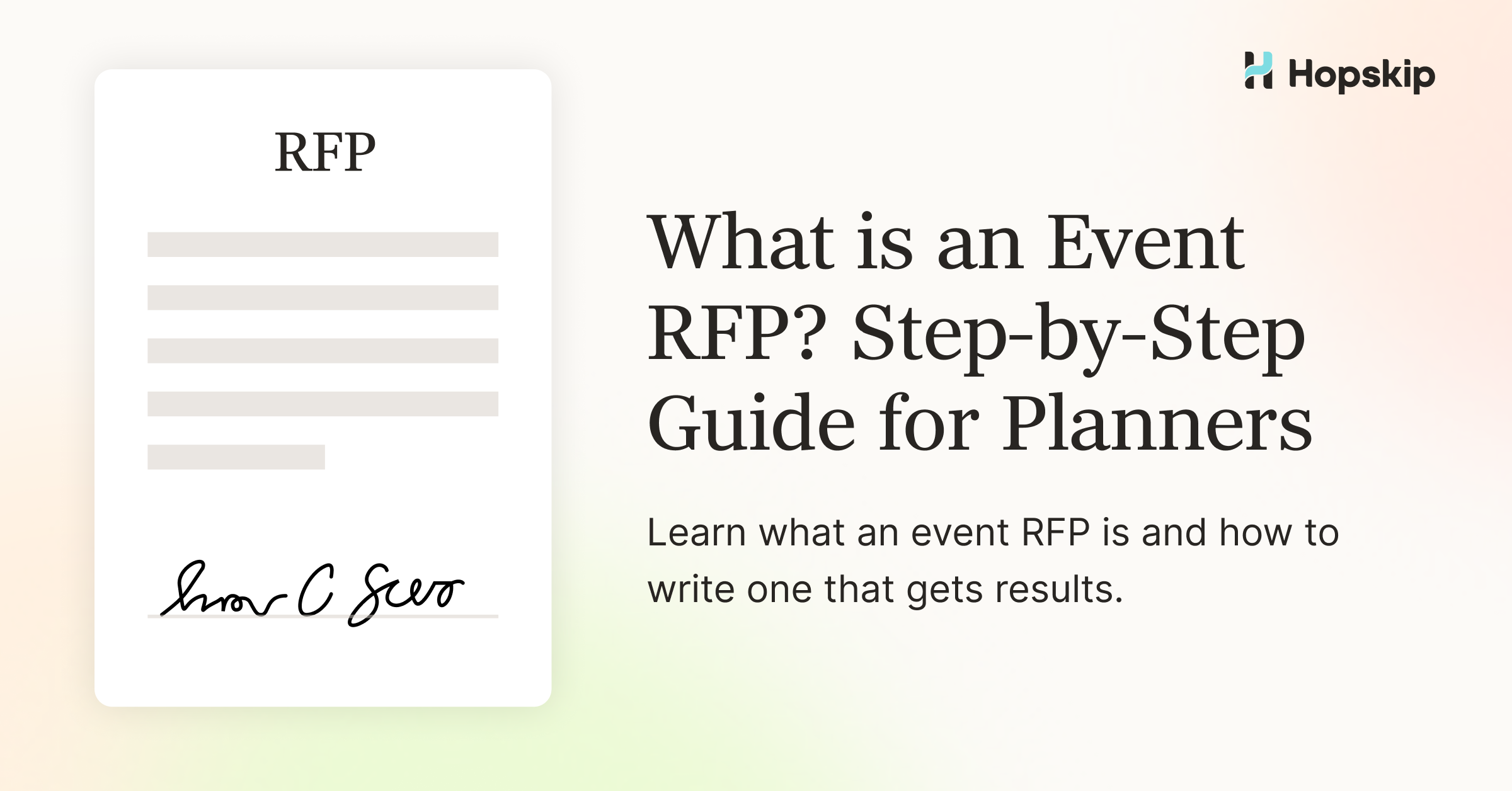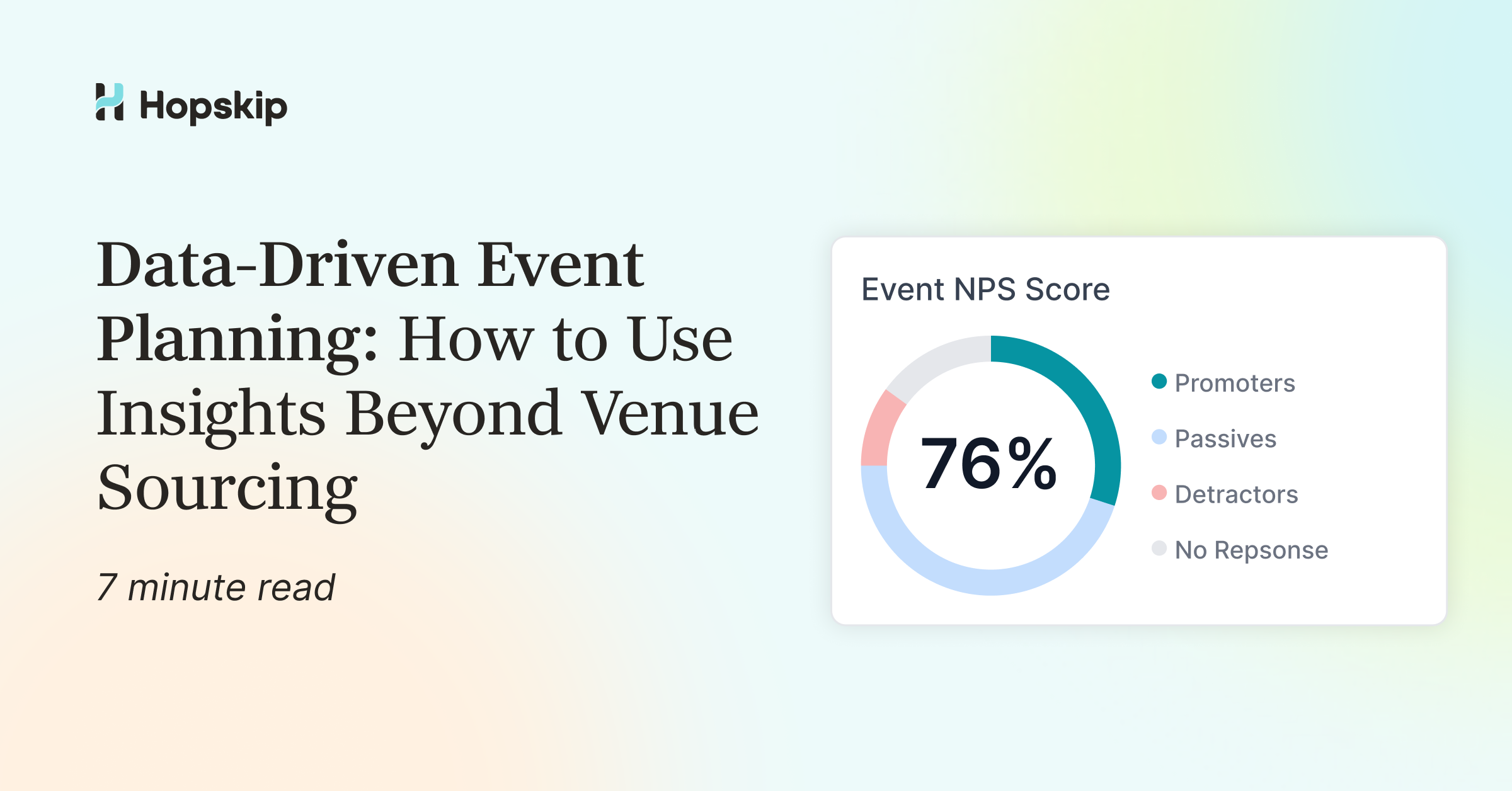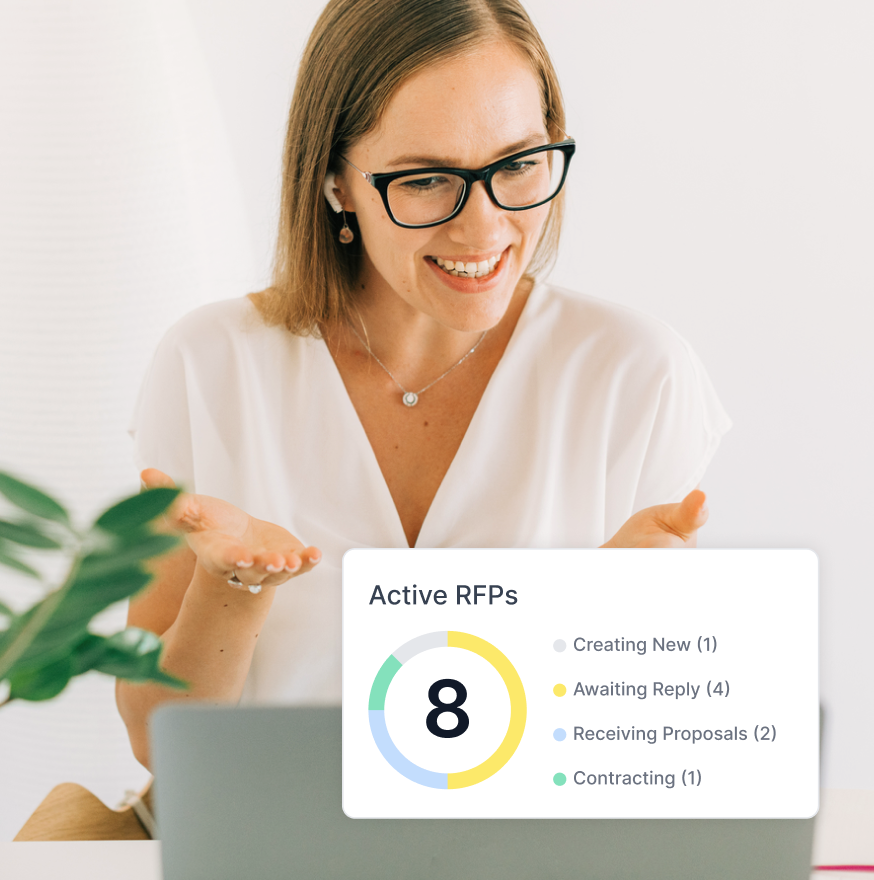RFP Best Practices
10 Event RFP Mistakes That Are Costing You Time (and Sanity)
Kate Robertson
Oct 28, 2025
Your event RFP shouldn’t feel like pulling teeth. Here’s how to fix the most common mistakes event planners make, and actually enjoy the process.
We get it. You’ve sent out your event RFP, and now you’re drowning in vague proposals, chasing vendors for basic answers, and wondering why this always takes three times longer than it should.
Sound familiar?
After working with hundreds of event planners at Hopskip, we’ve spotted the same RFP mistakes over and over again. The good news? They’re totally fixable. Let’s dive into the top 10 pitfalls, and how to dodge them like a pro.
1. Playing the Guessing Game with Event Objectives
The mistake: Your RFP says something like “need meeting space for corporate event” and… that’s it. Vendors are left playing 20 questions, and you’re stuck in email ping-pong hell.
Why it matters: When objectives are vague, vendors can’t tailor their proposals. You end up with cookie-cutter responses that completely miss what you’re actually trying to achieve.
The fix:
Start with a clear event purpose that tells the story: “We’re hosting our annual sales kickoff for 250 reps to energize the team, roll out Q1 priorities, and strengthen cross-regional networking.”
Add measurable outcomes when possible: “Goal: increase cross-department connections by 30%”.
Give vendors the why behind your event, not just the what. Context is everything.
2. Setting Vendors Up to Fail with Unrealistic Timelines
The mistake: You need proposals yesterday, vendors have 72 hours to respond, and somehow nobody’s delivering quality work. Shocking, right?
Why it matters: Rushed timelines = rushed proposals. When you squeeze vendors, they either decline to bid or submit half-baked responses that create more work for you down the line.
The fix:
Work backwards from your event date. Give vendors at least 3-4 weeks to respond (more for complex events).
Spell out your timeline clearly: “Proposals due March 15 at 5pm EST. Questions accepted through March 8. Final decision by March 29.”
Build in breathing room for Q&A, reviews, follow-ups, and contract negotiations.
Respecting vendor timelines means you’ll get their A-game—not their “thrown together on a Friday afternoon” game.
3. Overloading Your RFP with Unnecessary Information
The mistake: Your RFP is 47 pages long, includes your company’s entire history, and buries the actual requirements somewhere around page 23. Vendors need a map and a strong coffee just to get through it.
Why it matters: When your RFP is bloated with irrelevant details, vendors struggle to identify what actually matters. Important requirements get lost in the noise, and you end up with proposals that miss key points.
The fix:
Keep it focused. Lead with the essentials: event type, dates, attendee count, key objectives, and main requirements, meeting room requirements, food and beverage, A/V, and important clauses.
Use an appendix for supporting details: “See Appendix A for full company background, Appendix B for detailed technical specs.”
Create a one-page executive summary at the front that covers the critical information.
Think of your RFP like your event agenda, every element should earn its place. If vendors don’t need 10 pages about your company’s founding story to craft a great proposal, leave it out.
4. Creating a Features Wish List Instead of Defining Outcomes
The mistake: Your RFP reads like a shopping list: “Need 500 mics, shuttle service, event app, breakfast buffet…” But nowhere does it say what you’re actually trying to accomplish.
Why it matters: When you focus on features instead of outcomes, vendors treat you like a commodity buyer. They’ll check boxes but won’t bring strategic thinking to the table. A list of requirements is still required, but so is offering the bigger picture that includes your strategic goals.
The fix:
Flip your language from just “must include X, Y, Z” to “we need attendees to connect, engage, and take specific actions. We want your suggestions, but here is what we have in mind at a minimum for requirements…”
Connect features to outcomes: “We need live polling because we want 85% active session participation and real-time feedback we can use for day-two adjustments.”
Talk about behaviors, not just boxes to check.
This shift helps you evaluate proposals based on how well they’ll actually serve your goals—not just who has the longest feature list.
5. Being Too Rigid (or Not Saying Where You’re Flexible)
The mistake: Your RFP reads like it’s carved in stone—zero indication of what’s negotiable, what’s flexible, or where you’d welcome creative alternatives. Vendors assume everything is locked down and play it safe.
Why it matters: When you don’t signal flexibility, you miss out on innovative ideas and cost-saving alternatives that vendors could offer. Maybe those three breakout rooms could be configured differently. Maybe that Thursday start date could shift to Wednesday for better rates.
The fix:
Identify what’s truly non-negotiable versus where you have wiggle room: “Event dates are firm, but we’re flexible on check-in/check-out times and breakout room configurations.”
Explicitly invite alternatives: “If you have creative suggestions that achieve our goals differently, we’re all ears. Include them as optional proposals.”
Ask vendors directly: “Where do you see opportunities for optimization or alternative approaches?”
The best proposals often come when vendors know they have permission to think outside the box. Give them that permission—and be clear about where the boundaries actually are.
6. Playing Budget Poker (and Losing)
The mistake: You ask for proposals without mentioning budget, hoping vendors will magically read your mind. Or you throw out a number that’s wildly disconnected from the scope you’re describing.
Why it matters: No budget guidance means vendors either lowball (and cut essential elements) or go high-end (and waste everyone’s time when it’s outside your range).
The fix:
Provide a ballpark range, even if it’s approximate: “Total budget roughly $250K including venue and room block. F&B target under $120/person.”
If you’re unsure, be honest: “We’re estimating $X-Y range. Please propose tiered options at different service levels.”
Give vendors something to work with, and you’ll get proposals you can actually use.
Budget transparency saves time and prevents that awkward moment when you realize you’re $100K apart on expectations.
7. Writing the RFP in a Silo (aka Forgetting to Talk to Your Team)
The mistake: You draft the entire RFP solo without looping in your clients, or finance, marketing, AV, or catering. Then six weeks later, someone says “Wait, we need simultaneous interpretation?” Cool. Cool cool cool.
Why it matters: Missing stakeholder input early means you’ll be revising proposals, re-negotiating contracts, and generally creating chaos for yourself later.
The fix:
Before sending anything, gather your people: venue sourcing, AV/tech, F&B, finance, marketing, whoever touches this event.
Lock down the basics: attendee count, breakout structure, VIPs, dietary restrictions, tech requirements, brand guidelines.
Include a contact list in your RFP: “For venue questions, contact Sarah. For AV specs, contact James.” This prevents vendors from getting conflicting information.
A 30-minute alignment meeting upfront saves 30 hours of cleanup later.
8. Forgetting the Nitty-Gritty Logistics
The mistake: Your RFP mentions “hotel room block needed” but doesn’t specify how many nights, how many rooms, attrition terms, or pickup expectations. Vendors are left making wild assumptions.
Why it matters: Vague logistics = inaccurate proposals. You’ll get quotes that don’t reflect reality, leading to surprise costs and last-minute scrambling.
The fix:
Include a detailed event schedule: “Day 1 – Registration 4-6pm, networking reception 7-9pm, check-in from 3pm. Day 2 – General session 9-11am, lunch 11:15am-12:30pm, breakout tracks 1-3:30pm.”
Spell out room block specifics: nights needed, rooms per night, VIP/speaker rooms, early arrivals, late departures, anticipated 85% pickup rate.
Cover the details: loading dock access, session flip times, F&B volumes, AV setups.
The more specific you are now, the fewer “Oh, by the way…” conversations you’ll have later.
9. Shutting Down Vendor Questions
The mistake: You send the RFP and declare it done. Vendors have questions, but there’s no process for asking them—so they just guess. And we all know how that ends.
Why it matters: When vendors can’t get clarification, they make assumptions. Wrong assumptions lead to misaligned proposals that waste everyone’s time.
The fix:
Build in a Q&A window: “Submit questions by March 8, we’ll share responses by March 10.”
Encourage vendors to flag any assumptions they’re making if something’s unclear.
Share an FAQ or addendum with all bidders after collecting questions—so everyone’s working from the same playbook.
Fair process = better proposals = easier decision for you.
10. Ghosting Vendors After They Submit
The mistake: Proposals arrive, you move on to selection, and the vendors who didn’t make the cut never hear from you again. Radio silence. Tumbleweed central.
Why it matters: Event planning is a relationship business. Today’s “no” could be next year’s perfect venue. Burning bridges by going dark doesn’t serve anyone.
The fix:
Send a quick confirmation when proposals arrive: “Got it! We’ll review and respond by March 29.”
Keep shortlisted vendors updated on next steps.
When you select a winner, send brief, polite rejections to others. A simple “We’ve selected another vendor, but we appreciate your time and will keep you in mind for future events” goes a long way.
Close the loop with professionalism, and you’ll build a stronger vendor network for all your future events.
Make Your Next RFP Actually Work For You
Here’s the truth: A well-crafted RFP isn’t just about getting proposals—it’s about getting the right proposals from vendors who understand what you’re trying to accomplish. It’s about setting everyone up for success from day one.
At Hopskip, we’ve built our platform specifically for event planners who are tired of the RFP runaround. We make venue sourcing, room block management, and proposal comparison faster, clearer, and way less painful—so you can focus on creating amazing experiences instead of drowning in spreadsheets.
Before you send your next venue or vendor RFP, run through this checklist. You might be surprised at how much smoother the whole process becomes when you avoid these common pitfalls.
Ready to transform your RFP process? Let’s talk about how Hopskip can help.
Here’s to RFPs that don’t make you want to throw your laptop out the window. 🎉
Key Takeaways:
- Start with clear objectives and measurable outcomes
- Give vendors realistic timelines (3-4 weeks minimum)
- Customize your RFP and invite creative proposals
- Remain flexible where possible, and make sure vendors know
- Provide budget guidance—even if it’s a range
- Align with internal stakeholders before sending
- Include detailed logistics and schedules
- Create a process for vendor Q&A
- Follow up with all vendors, winners and non-winners alike
Related Resources:




